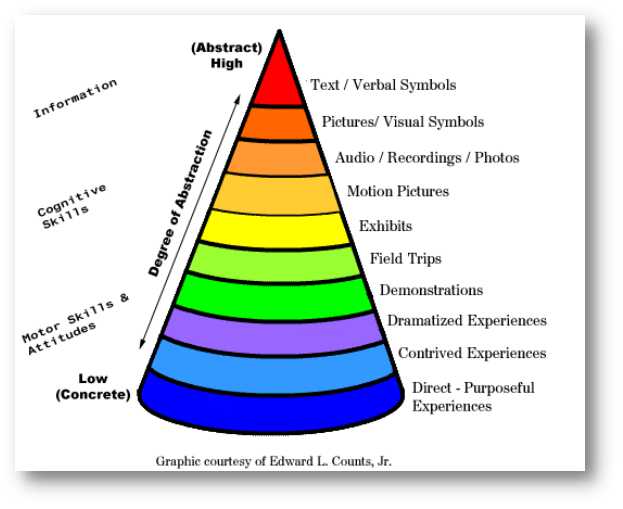 |
|
1 . Nonprojected Visuals (非投影图画) |
|
Nonprojected visuals can translate abstract ideas into a more realistic format. They also instruction to move down from the level of verbal symbols in Dale’s Cone of Experience to a more concrete level.
Next we will explore Six types of visuals commonly found in the classroom situation:
|
|
1.1 Still Pictures( 静态图片) Still pictures are photographic (or photograph like) representations of people, places, and things. 静止图片是对人物、地点和事物的照片式(或其他类似照片的图片)展示。 (1) Providing a group of pictures showing the same object or scene from several different angles or positions; 静态图片是二维的,为了弥补缺乏立体感的缺憾,可以使用同一物体或场景的一组不同角度或方位的图片; (2) A series of sequential still pictures can suggest motion; 一系列静态图片的连续使用可以形成动画效果; (3) Teacher-made or student-made photographs may illustrate and help teach specific lesson topics; 教师和学生制作的图片可作为对教学内容的解释,辅助课程教学的进行; (4) You may include skill in decoding textbook pictures in instructional objectives to motivate learners to use them for study purposes. 教师可以将对教科书中图片的理解能力作为教学目标之一,以此来激励学生为了学习目的使用图片。 |
|
1.2 Drawings (绘画) Drawings, sketches, and diagrams employ the graphic arrangement of lines to represent persons, places, things, and concepts. 绘画、草图和图解通过线条的排列来表现人物、地点、事物和概念。 一般而言,绘画比草图更完整、更具表现力,草图总是缺乏对细节的描述,图解一般用于描述关系或帮助阐述过程,如流程或结构。(见图 4.2 ) |
|
|
|
图4.2 使用视觉符号可以大大减少文字量,该图显示了俄罗斯 206 级鱼雷艇结构 |
|
1.3 Charts (图表) Charts are visual representations of abstract relationships such as chronologies, quantities, and hierarchies. 图表是对年代、数量和层级等抽象关系的形象表示。 (1) Organization charts show the structure or chain of command in an organization. Usually they deal with the interrelationship of personnel or departments. 组织结构图描述一个组织的命令结构或者命令链,它一般阐述了个人之间或部门之间的关系。 |
|
图4.3 组织结构图 |
|
(2) Classification charts are similar to organization charts but are used chiefly to classify or categorize objects, events, or species. 分类图表与组织结构图类似,但主要用于显示对象、事件、种类的分类。 |
|
图4.4 戴尔经验之塔是典型的分类图表 |
|
(3) Time lines illustrate chronological relationships between events. They are most often used to show historical events in sequence or the relationship of famous people and these events. Timelines are very helpful for summarizing a series of events. 时间年表用于阐述事件之间的年代顺序。最经常见的是用时间轴来表示顺序发生的历史事件,以及著名人物和相关事件之间的关系。对一系列事件进行总结时,时间年表是一种非常有用的整理、展示信息的图表工具。 |
|
图4.5 时间年表 |
|
(4) Tabular charts or tables, contain numerical information, or data. They are also convenient for showing time information when the data are presented in columns. 数据表或图表包含数字信息和数据,如果数据按时间顺序排列的话,数据表也可表示时间信息。 |
|
图4.6 数据图表 |
|
(5) Flowcharts , or process charts, show a sequence, a procedure, or the flow of a process. Flowcharts show how different activities, ingredients, or procedures are interrelated. 流程图表示一个顺序或一个程序,表示一个过程的流程。它显示了不同的事件、因素或步骤是如何关联起来的。 |
|
图4.7 流程图 |
|
A chart should have a clear, well-defined instructional purpose. If you are developing own charts, be sure they contain the minimum of visual and verbal information needed for understanding. |
|
1.4 Graphs (曲线图) Graphs provide a visual representation of numerical data. They also illustrate relationships among units of the data and trends in the data. 曲线图为数据提供了一种视觉表示,还可以描述数据之间的关系,以及数据的走向和趋势。 There are four major types of graphs:bar,pictorial,circle,and line. 主要的曲线图类型有 4 种:柱形图、示意图、饼图和折线图。 |
|
Bar graphs pictorial graphs |
|
Circle graphs line graphs |
|
图4.8 四种主要的曲线图类型 |
|
1.5 Posters (海报) Posters incorporate visual combinations of images, lines, color, and words. They are intended to catch and hold the viewer’s attention at least long enough to communicate a brief message. 海报是由图像、线条、颜色和文字等视觉元素组合形成的,它的目的是尽可能吸引和保持观众的注意力,以传达间断的信息。 |
|
|
|
图4.9 海报可以吸引观众的注意力,传递简明扼要的信息 |
|
|
1.6 Cartoons (漫画) Cartoons (line drawings that are rough caricatures of real people and events) are perhaps the most popular and familiar visual format. Humor and satire ( 讽刺 ) are mainstays 支柱 of the cartoonist’s skill. 漫画是用线条幽默地描绘出真实的人物和事件。 |
|
1.7 How to use Non-projected Visuals effectively?
|
2 . Projected Visuals (投影图画)2.1 Definition Projected visuals are defined here as media formats in which still images are enlarged and displayed on a screen. 可以把静态图像放大并显示在屏幕上的媒体形式。 (1) Such projection may be achieved by passing a strong light through transparent film; 一束强光透过透明的胶片 (2) Magnifying the image through a series of lenses; 利用一系列镜片组合把图像放大; (3) Casting this image onto a reflective surface; 静态画面被投射到一个反射面上; (4) The image can be displayed on a monitor using a document camera. 或者用实物展示台将图像显示在监视器上。 |
|
2.2 Integration (与课程的整合) 投影适合于所有年级、所有学科的教学。以下是投影媒体的一些典型应用:
|
Unit 5-知识点一:非投影图画、投影图画
Top Block Position
Unit 5-知识点一:非投影图画、投影图画
完成課程所需要的條件
最後修改: 2018年 11月 1日(週四) 11:46
Bottom Block Position


